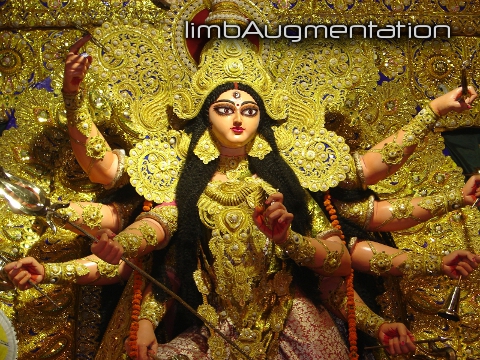Story changes the environment in which it is told.
Lucas Pawlik recently uploaded these videos to YouTube. They speak to the magic of myth and the mythic in magic. Enjoy!
Art Magic Technology
Story changes the environment in which it is told.
Lucas Pawlik recently uploaded these videos to YouTube. They speak to the magic of myth and the mythic in magic. Enjoy!
In this essay, Rachel Wagner looks at four types of immersive new media that address the issue of religious identity: Waco Resurrection, a religiously-inspired first-person shooter, Noah’s Ark, a religious online reality show; Roma Victor, a massive multiplayer online role-playing game, and religious experiences in the online world of Second Life.
Thanks to Adafruit for the heads-up on these sculptures by Theo Kamecke, featured this morning on Wired. Not occult per se, but they do have an esoteric quality to them, and bear some semblance to the work of Lemarchand. Check out the original article for more images and info.
There are many common themes between Transhumanism and different religions (Christianity, Buddhism, etc). There are also many new religions and sects based on Transhumanism. We’ll come together to discuss these overlaps and their sources.

I will be representing technopaganism, and will probably have something or two to say about cybernetics, as I usually do during h+ meetings. I may also touch on the idea of robotheosis.
What: Seattle h+ (Transhumanism) meeting
When: Friday, September 3, 7:00pm – 9:00pm
Where: Jigsaw Renaissance, 1026 Madison St., Seattle, WA 98104
Who: All are welcome to attend
Facebook link
Meetup.com link
The next method for impregnation is the so-called charge with magic volts, using, for this purpose, the electromagnetic fluid. The volt is charged, after its creation, with an electromagnetic fluid. The qualities of the intelligence in question are concentrated into the centre of the volt by help of imagination, imperturbable confidence and sure power, and are so condensed by repeated action that the metal of the talisman absorbs the volt. When the process of charging by volts is repeated, the magician has to concentrate on the wish that the intelligence in question is connected to that particular volt and that it will bring about by it the desired causes in the Akasha-world, and with them the desired effects. // Franz Bardon, The Practice of Magical Evocation
Conductive sigils — i.e. sigils that pass an electric current — offer many possible uses in multimedia rituals, both mechanically as switches etc., and sympathetically to add or combine some magical quality to/with an electrical action. E.g., we could use a conductive rune as a switch to turn on an engine (like the Rune Priests of the Adeptus Mechanicus). Sigils can be drawn with conductive inks on just about any surface including skin. 3D sigils may be sculpted from wire or other conductive materials. Sigils of varying resistances could initiate various actions depending on which sigil is selected.
Here is an example of a conductive sigil, which I made using the same tech for making printed circuit boards:
I first drew the sigil using Inkscape and GIMP, then laser-printed it (600dpi) to a transparency that I used to transfer the image to a photosensitive circuit board, which I then developed and etched (the circuit board, developer, and etch solution are available as a kit from Jameco). You can also just draw a sigil on a blank board, using a black Sharpie, and then etch that. The process may be as elaborate (consecrate the materials, employ them during appropriate hours, chant while etching, etc.) or simple as you care for.
To “charge” the sigil (no pun intended), I used Processing to play an appropriate song, and Arduino to send a voltage through the sigil, proportional to the varying amplitude of the song. Here are code examples for each application:
/**
* Charge Sigil (Processing)
* Joshua Madara
* oneirodynesystems.com
*
* Parts of this code were taken from
* Joshua Noble, _Programming Interactivity_, p.203
*/
import ddf.minim.*;
import processing.serial.*;
AudioPlayer mySong;
Minim minim;
Serial myPort;
int message = 0; // Holds the voltage value we'll send to Arduino
void setup(){
size(600, 400);
minim = new Minim(this);
myPort = new Serial(this, Serial.list()[0], 9600);
mySong = minim.loadFile("song_title.mp3");
}
void draw() {
fill(0x000000, 30);
rect(0, 0, width, height);
stroke(255);
noFill();
// Load buffer for mySong into array mix
float[] mix = mySong.mix.toArray();
// Draw waveform across screen
for(int i = 0; i < mySong.bufferSize() - 1; i++) {
ellipse(i * 4, 200 + mix[i]*100, 5, 5);
}
// Play mySong
mySong.play();
// Map first value of array mix to
// (rounded, integer) value between 0 and 255
// that corresponds to 0 to 5 volts in Arduino
// and set message to it
message = int(round(map(mix[1], -1, 1, 0, 255)));
// Send message to Arduino
myPort.write(message);
// println(message); // Uncomment to monitor message in Processing
}
// Stop and close minim
void stop() {
mySong.close();
minim.stop();
super.stop();
}
/**
* Charge Sigil (Arduino)
* Joshua Madara
* oneirodynesystems.com
*/
// Define variables for incoming message and output pin
int message = 0;
int outPin = 10;
void setup() {
// Initiate serial connection
Serial.begin(9600);
}
void loop() {
if(Serial.available() > 0) {
// Read message (0 to 255) from Processing, then...
message = Serial.read();
// ...set pin 10 to corresponding voltage (0 to 5 volts)
analogWrite(outPin, message);
}
}
To “evoke the spirit” of the sigil, I connect it in series with whatever ritual artifact(s) I am working with. E.g., a Scratch project might include the following script (assuming that the appropriate two wire pads on the sigil are connected to the Resistance-A input of the PicoBoard):

The “conditional stuff” could be any number of program blocks that manipulate graphics, play sounds, message other sprites to act, etc.
Here is a great video showing you how to etch using the same products as I did: